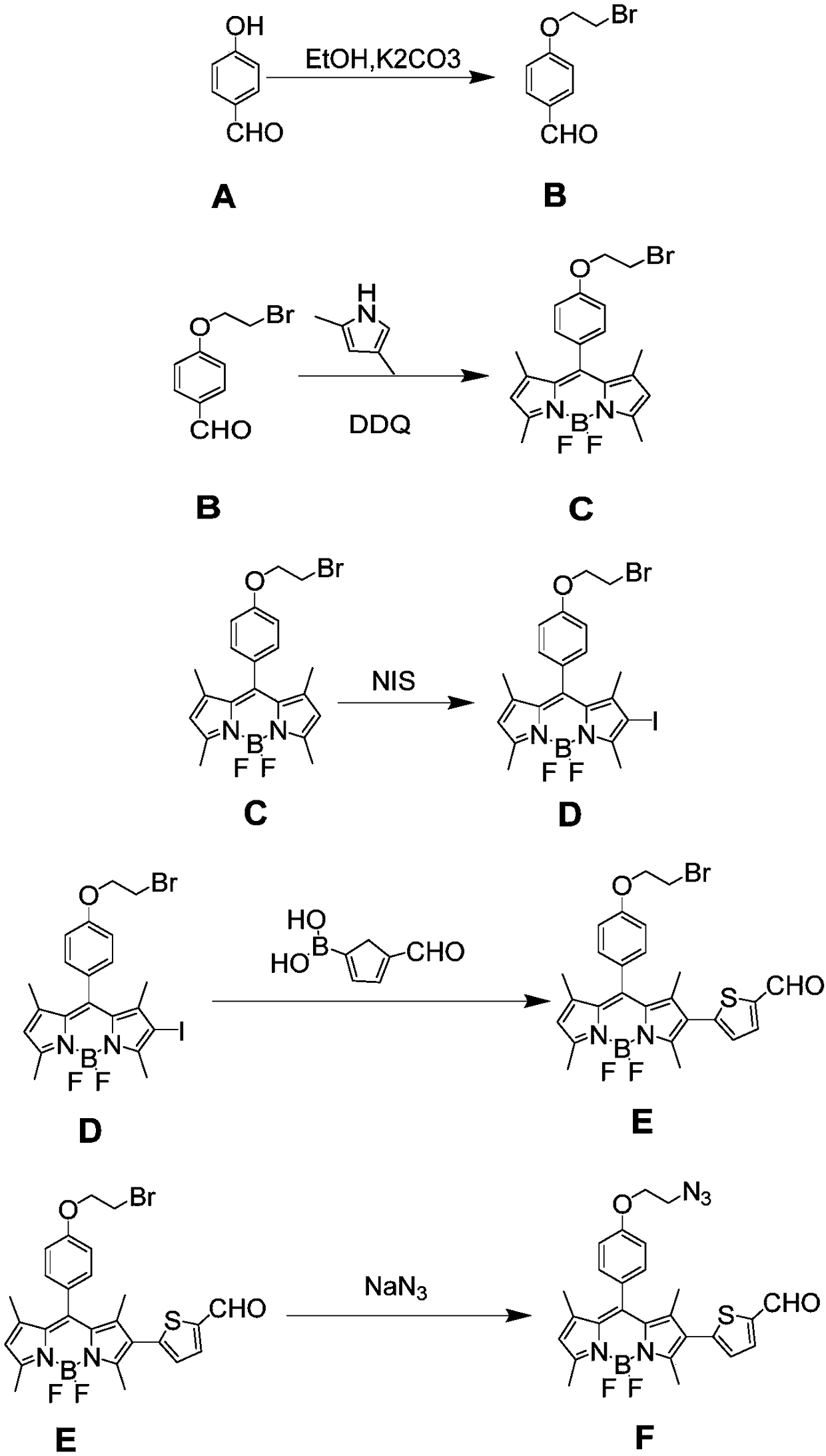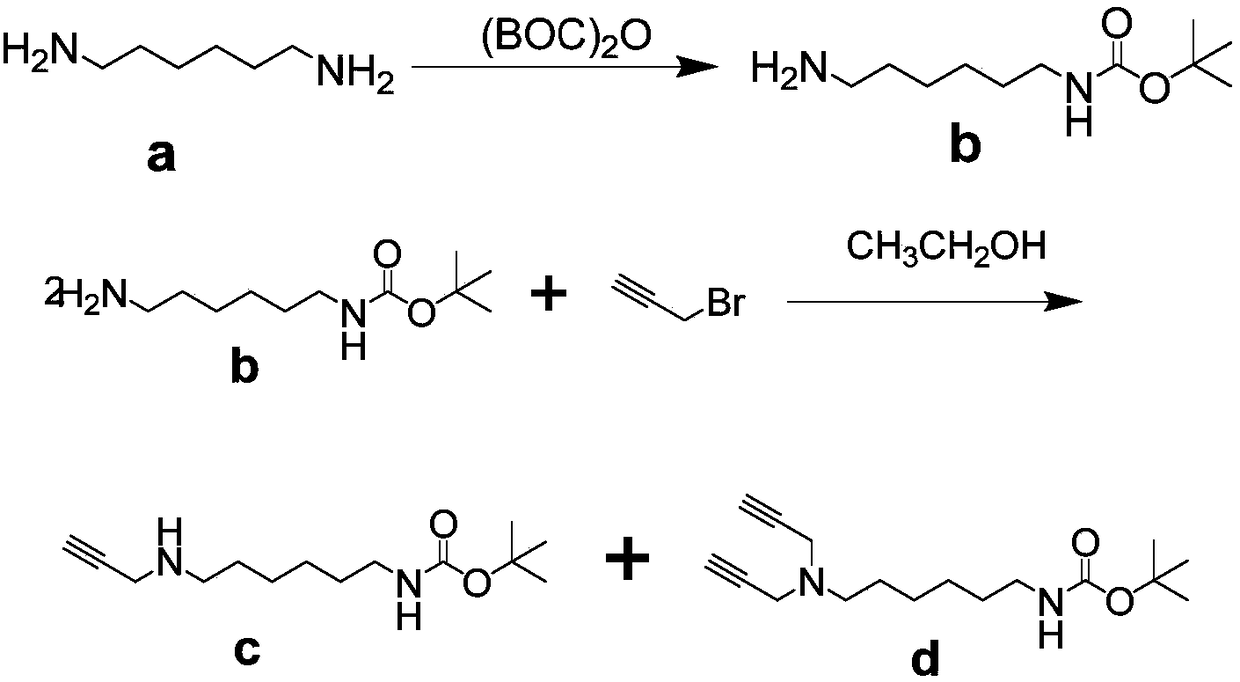Organic triplet photosensitive agent with host-guest recognition group and preparation method of organic triplet photosensitive agent
A technology of host-guest identification and triplet state, applied in the field of photosensitizers, can solve the problems of low conversion efficiency of photosensitizers, and achieve the effect of improving up-conversion efficiency
- Summary
- Abstract
- Description
- Claims
- Application Information
AI Technical Summary
Problems solved by technology
Method used
Image
Examples
Embodiment 1
[0070] The preparation method of the organic triplet photosensitizer with host-guest recognition group of this embodiment includes:
[0071] (1) Preparation of compound F:
[0072] Synthetic route such as figure 1 Shown.
[0073] (11) Compound B is synthesized using compound A and 1,2-dibromoethane. The specific process is as follows:
[0074] Hydroxybenzaldehyde was dissolved in ethanol, and then 1,2-dibromoethane and potassium carbonate were added to react at 78°C for 8 hours. After confirming the completion of the reaction by thin-layer chromatography, it was filtered and purified to obtain compound B; The molar ratio of hydroxybenzaldehyde, 1,2-dibromoethane and potassium carbonate is 1:5:1, and the developing agent used in thin-layer chromatography is dichloromethane. The specific purification process in this step is: extract the reaction product with dichloromethane, combine the organic phases, and use anhydrous Na 2 SO 4 After drying and using a rotary evaporator to remove th...
Embodiment 2
[0103] The difference between this embodiment and embodiment 1 is that the reaction conditions of each step are slightly different, and the details are as follows:
[0104] The preparation method of the organic triplet photosensitizer with host-guest recognition group of this embodiment includes:
[0105] (1) Preparation of compound F:
[0106] (11) Compound B is synthesized using compound A and 1,2-dibromoethane. The specific process is as follows:
[0107] Hydroxybenzaldehyde was dissolved in ethanol, and then 1,2-dibromoethane and potassium carbonate were added to react at 75°C for 7.5 hours. After confirming the completion of the reaction by thin layer chromatography, it was filtered and purified to obtain compound B; The molar ratio of hydroxybenzaldehyde, 1,2-dibromoethane and potassium carbonate is 1:4.8:1, and the developing agent used in thin layer chromatography is dichloromethane.
[0108] (12) The compound B is reacted with 2,4-dimethylpyrrole and trifluoroacetic acid in a...
Embodiment 3
[0126] The difference between this embodiment and embodiment 1 is that the reaction conditions of each step are slightly different, and the details are as follows:
[0127] The preparation method of the organic triplet photosensitizer with host-guest recognition group of this embodiment includes:
[0128] (1) Preparation of compound F:
[0129] (11) Compound B is synthesized using compound A and 1,2-dibromoethane. The specific process is as follows:
[0130] Dissolve hydroxybenzaldehyde in ethanol, then add 1,2-dibromoethane and potassium carbonate to react at 80°C for 8.5h. After confirming that the reaction is complete by thin-layer chromatography with dichloromethane, filter and purify to obtain the compound B; Among them, the molar ratio of hydroxybenzaldehyde, 1,2-dibromoethane and potassium carbonate is 1:5.5:1.2, and the developing agent used in thin layer chromatography is dichloromethane.
[0131] (12) The compound B is reacted with 2,4-dimethylpyrrole and trifluoroacetic aci...
PUM
 Login to View More
Login to View More Abstract
Description
Claims
Application Information
 Login to View More
Login to View More - R&D
- Intellectual Property
- Life Sciences
- Materials
- Tech Scout
- Unparalleled Data Quality
- Higher Quality Content
- 60% Fewer Hallucinations
Browse by: Latest US Patents, China's latest patents, Technical Efficacy Thesaurus, Application Domain, Technology Topic, Popular Technical Reports.
© 2025 PatSnap. All rights reserved.Legal|Privacy policy|Modern Slavery Act Transparency Statement|Sitemap|About US| Contact US: help@patsnap.com



